Towards Developing a New Model for Inclusive Cities in China—The Case of Xiong’an New Area
Abstract
1. Introduction
2. Theorizing and Conceptualizing “Urban Inclusiveness”
3. Methods and Materials
3.1. Evaluation Framework for Urban Inclusiveness
3.2. Overview on Xiong’an
- (1)
- Development mode transition: transforming the model of driving economic growth through urban competition to build a new model of synergistic development of the Beijing–Tianjin–Hebei city cluster, with Xiong’an as the engine;
- (2)
- Institutional innovation to be more inclusive: using economies of scale and specialization as two key strategies to relocate noncapital functions of Beijing, including high education institutions, health institutions, financial institutions, corporate headquarters, and high-tech industries;
- (3)
- Multiple spatial planning: utilizing Xiong’an’s advantage as a newly designed area to promote spatial planning considering multiple characteristics—combining the factors of topography, climate, history, and culture—to design the urban functional areas of Xiong’an;
- (4)
- Eco-service renovation: rehabilitating the Baiyangdian ecosystem and increasing the forest covered area to reach 70 per cent blue–green space;
- (5)
- Enhancing environmental inclusion: to forward environmental system innovation, via creating green and low-carbon production lifestyles and operational models for urban construction, and encouraging green transportation, smart power supply systems, and recycling-based sanitation systems;
- (6)
- Talent hub incubation: introducing innovative talents to develop high-tech industries and to build an international first-class innovative city;
- (7)
- Cultural renovation: promoting cultural creation and tourism development with traditional Chinese culture.
3.3. The Inclusive Development Indicators (IDIs) Selection for Xiong’an
3.4. Data Collection
4. Results
4.1. The Causal Network of Xiong’an IDIs
- The root nodes that have been chosen are population growth, industrial/technology development, and governance, which are the drivers of urbanization. Population growth and technological progress have contributed to regional economic prosperity, and these two factors have further attracted immigrations to live and work in order to obtain better living conditions. These elements drive urban development, while at the same time creating many resource, environmental, and social pressures.
- The central nodes are land use, transport, ecosystem service, and human resources, which are directly influenced by the root nodes and lead to changes in the state of urban inclusive development. Meanwhile, driving forces also induce pressures on mineral use, energy use, water use, healthcare, and immigration, and then shape the state indicators.
- The state is represented by measurable indicators drawn from local statistical resources corresponding to the pressures.
- The end-of-chain nodes are distribution of basic services, income equality, and ecological harmony, typically where the effects of multiple pressures become visible. These impact elements demonstrate the stages and progress of inclusive urban development.
- Response measures are taken to eliminate negative impact on the states of the city due to pressures, in this case led by governance, and are represented by the following indicators: immigration policy, land policy, education and training programs, research and development investment, infrastructure investment, environmental regulations, and financial policy. These policies, investments, and programs are countermeasures for mitigating pollution, promoting sustained economic growth, and guaranteeing high living standards for local residents as well as immigrants.
4.2. Xiong’an’s Inclusive Development Process
4.2.1. Land and Housing
Initial State
Innovative Policy for Land and Residential Area Development
Status Quo of the Housing Market
4.2.2. Transportation
Initial State
Policies and Programs
Up-to-Date Progress
4.2.3. Education and Training
Initial State
Education and Employment Support Policies
Up-to-Date Progress
4.2.4. Ecological Services
Initial State
Protective Policies and Measures
Up-to-Date Progress
5. Discussion
5.1. Fairness of the New Land Policy and the Housing Purchase System
5.2. Matching Public Services with Diverse Needs
5.3. Social Integration Issues and Employment Pressure
5.4. Ecological Protection and Resource Allocation
6. Conclusions
Author Contributions
Funding
Conflicts of Interest
Appendix A
| Categories | Indicators | Goals in 2035 |
| Innovative intelligence | 1.1 The proportion of research & experimental development expenditures of the whole society in the regional GDP (%) | 6 |
| 1.2 The proportion of basic research funds in research & experimental development funds (%) | 18 | |
| 1.3 Possession of invention patents per 10,000 people (pieces) | 100 | |
| 1.4 Contribution rate of scientific & technological progress (%) | 80 | |
| 1.5 Proportion of public education investment in regional GDP (%) | ≥5 | |
| 1.6 The proportion of digital economy in GDP of urban areas (%) | ≥80 | |
| 1.7 Contribution rate of big data in refined urban governance and emergency management (%) | ≥90 | |
| 1.8 Intelligent level of infrastructure (%) | ≥90 | |
| 1.9 High-speed broadband standard | Full coverage of high-speed broadband wireless communications, Gigabit-level in households, 10 Gigabit-level in enterprises | |
| Green ecology | 2.1 Proportion of blue–green space (%) | ≥70 |
| 2.2 Forest coverage (%) | 40 | |
| 2.3 Proportion of cultivated land protection area in the total area of the region (%) | 18 | |
| 2.4 Percentage of permanent basic farmland protection area in the total area of the region (%) | ≥10 | |
| 2.5 Urban green coverage rate in start-up area (%) | ≥50 | |
| 2.6 Per capita urban park area in the start-up area (m2) | ≥20 | |
| 2.7 The coverage of the 300 m service radius of the park in the start-up area (%) | 100 | |
| 2.8 The total length of the backbone greenway in the start-up area (km) | 300 | |
| 2.9 Water quality compliance rate of important water function areas (%) | ≥95 | |
| 2.10 Total annual runoff control rate of rainwater (%) | ≥85 | |
| 2.11 Water supply guarantee rate (%) | ≥97 | |
| 2.12 Sewage collection and treatment rate (%) | ≥99 | |
| 2.13 Utilization rate of waste water recycling (%) | ≥99 | |
| 2.14 Green building standard compliance rate of newly built civil buildings (%) | 100 | |
| 2.15 Annual average concentration of fine particles (PM2.5) (μg/m3) | Atmospheric environmental quality is fundamentally improved. | |
| 2.16 Harmless treatment rate of domestic garbage (%) | 100 | |
| 2.17 Utilization rate of urban domestic garbage recycling resources (%) | >45 | |
| Well-being | 3.1 15 min community life circle coverage rate (%) | 100 |
| 3.2 Per capita construction area of public cultural service facilities (m2) | 0.8 | |
| 3.3 Per capita public sports land area (m2) | 0.8 | |
| 3.4 Average years of education (years) | 13.5 | |
| 3.5 Number of beds in medical and health institutions (sheets/1000 person) | 7.0 | |
| 3.6 Population density in planned construction area (person/km2) | ≤10000 | |
| 3.7 Road network density in start-up area (km/km2) | 10–15 | |
| 3.8 Proportion of green transportation trips in the start-up area (%) | ≥90 | |
| 3.9 Proportion of public transport in motorized travel in start-up areas (%) | ≥80 | |
| 3.10 Service radius of public transportation station in start-up area (m) | ≤300 | |
| 3.11 Public transport service coverage rate of municipal road in starting area (%) | 100 | |
| 3.12 Area of emergency refuge per capita (m2) | 2–3 |
References
- Dong, L.; Liang, H. Spatial analysis on China’s regional air pollutants and CO2 emissions: Emission pattern and regional disparity. Atmos. Environ. 2014, 92, 280–291. [Google Scholar] [CrossRef]
- Dong, L.; Liang, H.; Gao, Z.; Luo, X.; Ren, J. Spatial distribution of China’s renewable energy industry: Regional features and implications for a harmonious development future. Renew. Sustain. Energy Rev. 2016, 58, 1521–1531. [Google Scholar] [CrossRef]
- China NBoSo. Statistical Communiqué on the National Economic and Social Development of the People’s Republic of China; National Bureau of Statistics of China: Beijing, China, 2020.
- OECD: Income Inequality (Indicator). Available online: https://www.oecd-ilibrary.org/social-issues-migration-health/income-inequality/indicator/english_459aa7f1-en (accessed on 8 March 2020).
- Dong, H.; Fujita, T.; Geng, Y.; Dong, L.; Ohnishi, S.; Sun, L.; Dou, Y.; Fujii, M. A review on eco-city evaluation methods and highlights for integration. Ecol. Indic. 2016, 60, 1184–1191. [Google Scholar] [CrossRef]
- Stronks, K.; Ravelli, A.C.; Reijneveld, S.A. Immigrants in the Netherlands: Equal access for equal needs? J. Epidemiol. Community Health 2001, 55, 701–707. [Google Scholar] [CrossRef] [PubMed]
- World Bank, Development Research Center of the State Council The People’s Republic of China. Urban China: Toward Efficient, Inclusive, and Sustainable Urbanization; World Bank: Washington, DC, USA, 2014. [Google Scholar] [CrossRef]
- Harrison, J. Life after regions? The evolution of city-regionalism in England. Reg. Stud. 2012, 46, 1243–1259. [Google Scholar] [CrossRef]
- Storper, M. Keys to the City: How Economics, Institutions, Social Interaction, and Politics Shape Development; Princeton University Press: Princeton, NJ, USA, 2013. [Google Scholar]
- Lee, N. Inclusive growth in cities: A sympathetic critique. Reg. Stud. 2019, 53, 424–434. [Google Scholar] [CrossRef]
- Benner, C.; Pastor, M. Equity, Growth, and Community: What the Nation can Learn From America’s Metro Areas; University of California Press: Oakland, CA, USA, 2015. [Google Scholar]
- Plunkett, J. Growth Without Gain; Resolution Foundation: London, UK, 2011. [Google Scholar]
- Summers, L.H.; Balls, E. Report of the Commission on Inclusive Prosperity; Center for American Progress: Wahshington, DC, USA, 2015. [Google Scholar]
- Cavanaugh, A.; Breau, S. Locating geographies of inequality: Publication trends across OECD countries. Reg. Stud. 2018, 52, 1225–1236. [Google Scholar] [CrossRef]
- Espino, N.A. Building the Inclusive City: Theory and Practice for Confronting Urban Segregation; Routledge: Abingdon, UK, 2015. [Google Scholar]
- Kireyev, A.; Chen, J. Inclusive Growth Framework; International Monetary Fund: Washington, DC, USA, 2017. [Google Scholar]
- Samans, R.; Blanke, J.; Drzeniek, M.; Corrigan, G. The Inclusive Development Index 2018 Summary and Data Highlights; World Economic Forum: Geneva, Switzerland, 2018. [Google Scholar]
- Laquian, A.A.; Hanley, L.M. The Inclusive City: Infrastructure and Public Services for the Urban Poor in Asia; Johns Hopkins University Press: Baltimore, MA, USA, 2007. [Google Scholar]
- Sharma, D. Inclusive urban development: Role of institutions and governance. Int. J. Regul. Gov. 2010, 10, 91–102. [Google Scholar] [CrossRef]
- de Jong, M. From eco-civilization to city branding: A neo-marxist perspective of sustainable urbanization in China. Sustainability 2019, 11, 5608. [Google Scholar] [CrossRef]
- Lu, H.; de Jong, M. Evolution in city branding practices in China’s Pearl River Delta since the year 2000. Cities 2019, 89, 154–166. [Google Scholar] [CrossRef]
- Hanusch, M. Republic of South Africa Systematic Country Diagnostic: An Incomplete Transition Overcoming the Legacy of Exclusion in South Africa; World Bank: Washington, DC, USA, 2018. [Google Scholar]
- Burgard, S. Race and pregnancy-related care in Brazil and South Africa. Soc. Sci. Med. 2004, 59, 1127–1146. [Google Scholar] [CrossRef] [PubMed]
- Salisbury, T. Education and inequality in South Africa: Returns to schooling in the post-apartheid era. Int. J. Educ. Dev. 2016, 46, 43–52. [Google Scholar] [CrossRef]
- Steinberg, S. Occupational Apartheid in America: Race, Labor Market Segmentation, and Affirmative Action. In Without Justice For All; Routledge: Abingdon, UK, 2018; pp. 215–233. [Google Scholar]
- Phelps, M.S.; Prock, G.A. Equality of Educational Opportunity in Rural America. In Rural Education (1991): Issues and Practice; Deyoung, A., Ed.; Taylor & Frauncis Group: Abingdon, UK, 2017; p. 269. [Google Scholar]
- Redmond, P.; McGuinness, S. The gender wage gap in Europe: Job preferences, gender convergence and distributional effects. Oxf. Bull. Econ. Stat. 2019, 81, 564–587. [Google Scholar] [CrossRef]
- Dong, L.; Liang, H.; Zhang, L.; Liu, Z.; Gao, Z.; Hu, M. Highlighting regional eco-industrial development: Life cycle benefits of an urban industrial symbiosis and implications in China. Ecol. Model. 2017, 361, 164–176. [Google Scholar] [CrossRef]
- Dou, Y.; Luo, X.; Dong, L.; Wu, C.; Liang, H.; Ren, J. An empirical study on transit-oriented low-carbon urban land use planning: Exploratory Spatial Data Analysis (ESDA) on Shanghai, China. Habitat Int. 2016, 53, 379–389. [Google Scholar] [CrossRef]
- Dong, L.; Wang, Y.; Scipioni, A.; Park, H.-S.; Ren, J. Recent progress on innovative urban infrastructures system towards sustainable resource management. Resour. Conserv. Recycl. 2018, 128, 355–359. [Google Scholar] [CrossRef]
- Fransen, K.; Boussauw, K.; Deruyter, G.; de Maeyer, P. The relationship between transport disadvantage and employability: Predicting long-term unemployment based on job seekers’ access to suitable job openings in Flanders, Belgium. Transp. Res. Part A Policy Pract. 2019, 125, 268–279. [Google Scholar] [CrossRef]
- Ianchovichina, E.; Lundstrom, S. Inclusive Growth Analytics: Framework and Application; The World Bank: Washington, DC, USA, 2009. [Google Scholar]
- Spence, M. The Growth Report: Strategies for Sustained Growth and Inclusive Development; World Bank: Washington, DC, USA, 2008. [Google Scholar]
- Bian, Y.; Dong, L.; Liu, Z.; Zhang, L. A sectoral eco-efficiency analysis on urban-industrial symbiosis. Sustainabiliy 2020, 12, 3650. [Google Scholar] [CrossRef]
- UN-Habitat. Inclusive Cities Initiative: The Way Forward. Nairobi: UN Habitat. Available online: https://www.unhabitat.org/downloads/docs/2115_40209_inclusive_cities_WHD.doc (accessed on 20 March 2019).
- Luo, X.; Dong, L.; Dou, Y.; Li, Y.; Liu, K.; Ren, J.; Liang, H.; Mai, X. Factor decomposition analysis and causal mechanism investigation on urban transport CO2 emissions: Comparative study on Shanghai and Tokyo. Energy Policy 2017, 107, 658–668. [Google Scholar] [CrossRef]
- Luo, X.; Dong, L.; Dou, Y.; Liang, H.; Ren, J.; Fang, K. Regional disparity analysis of Chinese freight transport CO2 emissions from 1990 to 2007: Driving forces and policy challenges. J. Transp. Geogr. 2016, 56, 1–14. [Google Scholar] [CrossRef]
- Sun, L.; Li, H.; Dong, L.; Fang, K.; Ren, J.; Geng, Y.; Fujii, M.; Zhang, W.; Zhang, N.; Liu, Z. Eco-benefits assessment on urban industrial symbiosis based on material flows analysis and emergy evaluation approach: A case of Liuzhou city, China. Resour. Conserv. Recycl. 2017, 119, 78–88. [Google Scholar] [CrossRef]
- Xue, Y.; Xiang, P.; Jia, F.; Liu, Z. Risk Assessment of High-Speed Rail Projects: A Risk Coupling Model Based on System Dynamics. Int. J. Environ. Res. Public Health 2020, 17, 5307. [Google Scholar] [CrossRef] [PubMed]
- Whitzman, C.; Legacy, C.; Andrew, C.; Shaw, M.; Klodawsky, F. Building Inclusive Cities: Women’s Safety and the Right to the City; Routledge: Abingdon, UK, 2013. [Google Scholar]
- Hanson, J. The Inclusive City: Delivering a More Accessible Urban Environment Through Inclusive Design. In Proceedings of the Cobra 2004: RICS International Construction Conference, Responding to Change, Headingley, UK, 7–8 September 2004. [Google Scholar]
- Mackett, R.L.; Achuthan, K.; Titheridge, H. AMELIA: A tool to make transport policies more socially inclusive. Transp. Policy 2008, 15, 372–378. [Google Scholar] [CrossRef]
- Morissens, A.; Sainsbury, D. Migrants’ social rights, ethnicity and welfare regimes. J. Soc. Policy 2005, 34, 637–660. [Google Scholar] [CrossRef]
- Serageldin, M. Inclusive Cities and Access to Land, Housing, and Services in Developing Countries. In Urban Development Series Knowledge Papers No. 22; World Bank: Washington, DC, USA, 2016. [Google Scholar]
- Hu, W.; Wang, R. Which Chinese cities are more inclusive and why? Cities 2019, 86, 51–61. [Google Scholar] [CrossRef]
- Alessandria, F. Inclusive city, strategies, experiences and guidelines. Procedia Soc. Behav. Sci. 2016, 223, 6–10. [Google Scholar] [CrossRef]
- Broadhead, J. Inclusive Cities Inclusive Practices for Newcomers at City Level and Examples of Innovation from Overseas. Background Paper for the First Meeting of the Inclusive Cities UK Working Group; University of Oxford: Oxford, UK, 2017. [Google Scholar]
- Liu, C.Y.; Hu, F.Z.; Jeong, J. Towards inclusive urban development? New knowledge/creative economy and wage inequality in major Chinese cities. Cities 2019, in press. [Google Scholar] [CrossRef]
- Ekins, P.; Simon, S.; Deutsch, L.; Folke, C.; De Groot, R. A framework for the practical application of the concepts of critical natural capital and strong sustainability. Ecol. Econ. 2003, 44, 165–185. [Google Scholar] [CrossRef]
- Naik, S.; Ramola, Michael, L. Manual for Undertaking National Urban Assessments; Asian Development Bank: Mandaluyong, Philippines, 2016. [Google Scholar]
- Singru, R.; NaikLindfield, M.R. Enabling Inclusive Cities: Tool Kit for Inclusive Urban Development; Asian Development Bank: Mandaluyong, Philippines, 2017. [Google Scholar]
- Niemeijer, D.; de Groot, R.S. Framing environmental indicators: Moving from causal chains to causal networks. Environ. Dev. Sustain. 2008, 10, 89–106. [Google Scholar] [CrossRef]
- Rauniyar, G.; Kanbur, R. Inclusive growth and inclusive development: A review and synthesis of Asian Development Bank literature. J. Asia Pac. Econ. 2010, 15, 455–469. [Google Scholar] [CrossRef]
- McDonald, J. Adaptive intelligent power systems: Active distribution networks. Energy Policy 2008, 36, 4346–4351. [Google Scholar] [CrossRef]
- Hebei Provincial People’s Government. Hebei Xiong’an New Area Plan Outline (2018). Available online: http://www.xiongan.gov.cn/2018-04/21/c_129855813.htm (accessed on 8 March 2020).
- Zhenyu, Y.; Xingxing, F.; Zengbo, B. Problems and prospective analysis of the urbanization of Xiong’an New Area. Dev. Res. 2018, 3, 40–43. (In Chinese) [Google Scholar]
- National Development and Reform Commission, PRC. 2018–2035 Master Plan for Xiong’an New Area. Available online: http://www.xiongan.gov.cn/2019-01/13/c_1210036983.htm (accessed on 8 April 2019).
- Xiaoliang, H.; Deting, Y.; Xiaohong, M. Research Report on Population Development in Beijing (2018); Social Science Academic Press (China): Beijing, China, 2018. [Google Scholar]
- Hebei Xiong’an New Area Management Committee. Ten Plans to Enhance Employment and Entrepreneurship in Xiong’an New Area. Available online: http://www.xiongan.gov.cn/2020-03/10/c_1210508732.htm (accessed on 5 April 2020).
- Inc Baidu. Big Data Report of Xiong’an New Area. Available online: http://www.xiongan.gov.cn/2020-01/13/c_1210437343.htm (accessed on 15 March 2020).
- Ge, Q.; Yang, L.; Jin, F.; Zhu, H. Carrying capacity of resource and environment of xiongan new area: Evaluation, regulation, and promotion. J. Remote Sens. 2017, 32, 1206–1215. [Google Scholar]
- Hebei Xiong’an New Area Management Committee. Cooperation Agreement for Health Care Development in Xiong’an New Area. Available online: http://www.gov.cn/xinwen/2018-09/14/content_5322042.htm (accessed on 10 April 2020).
- Liu, Z. Institution and inequality: The hukou system in China. J. Comp. Econ. 2005, 33, 133–157. [Google Scholar] [CrossRef]
- Huang, D.; Chan, R. On ‘land finance’ in urban China: Theory and practice. Habitat Int. 2018, 75, 96–104. [Google Scholar] [CrossRef]
- UNESCO. The United Nations World Water Development Report 4: Managing Water under Uncertainty and Risk; WWAP (World Water Assessment Programme): Paris, France, 2012. [Google Scholar]
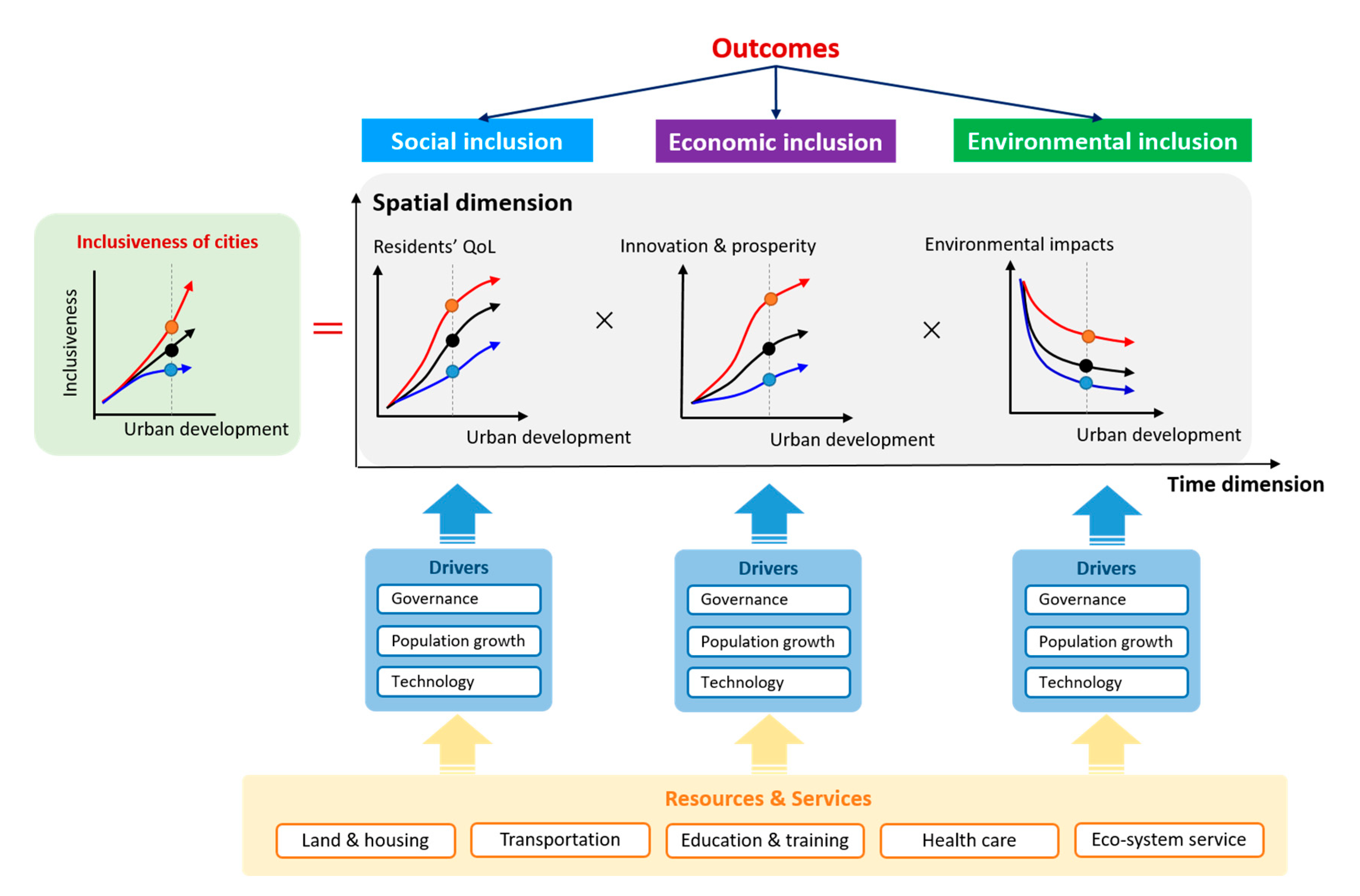
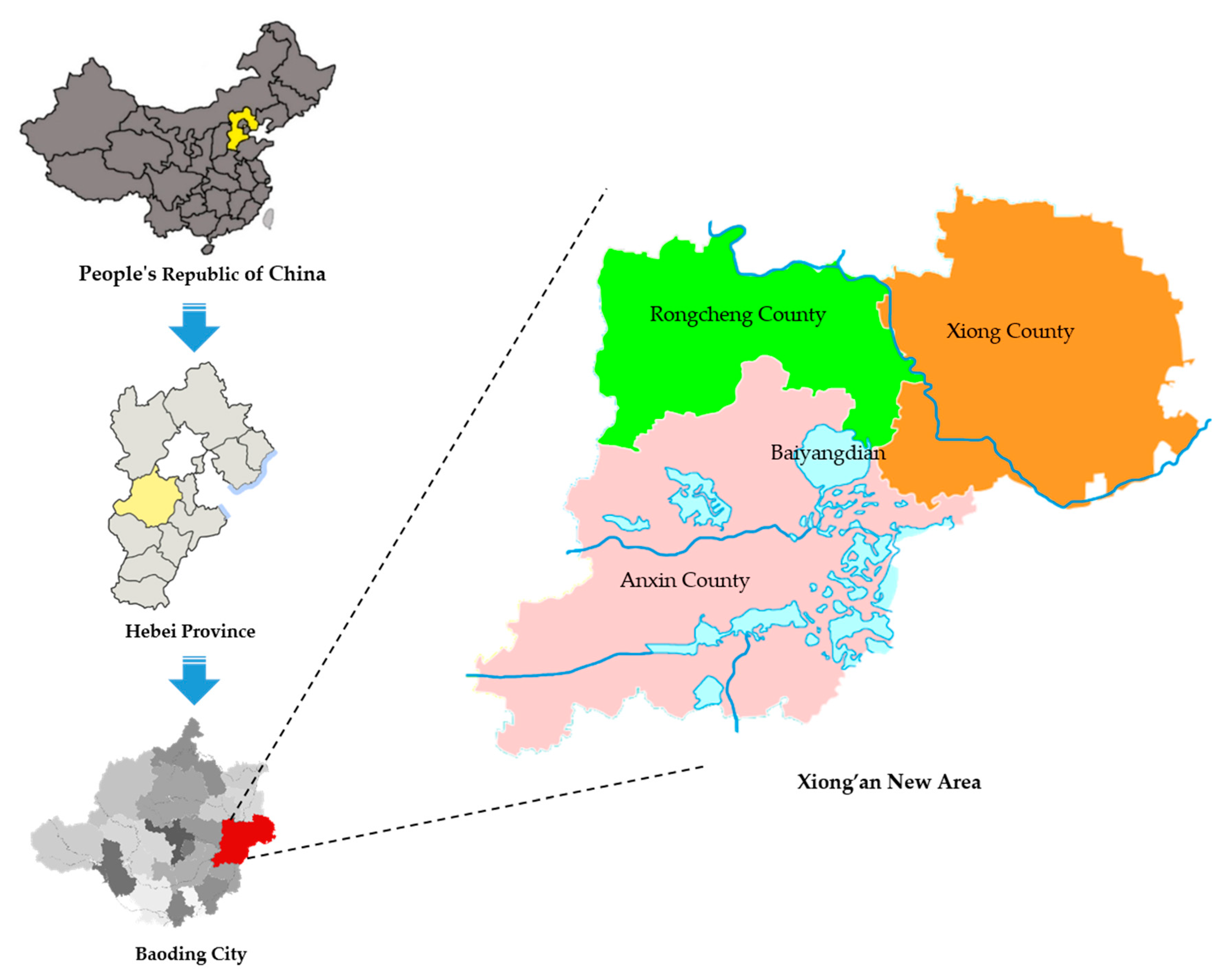
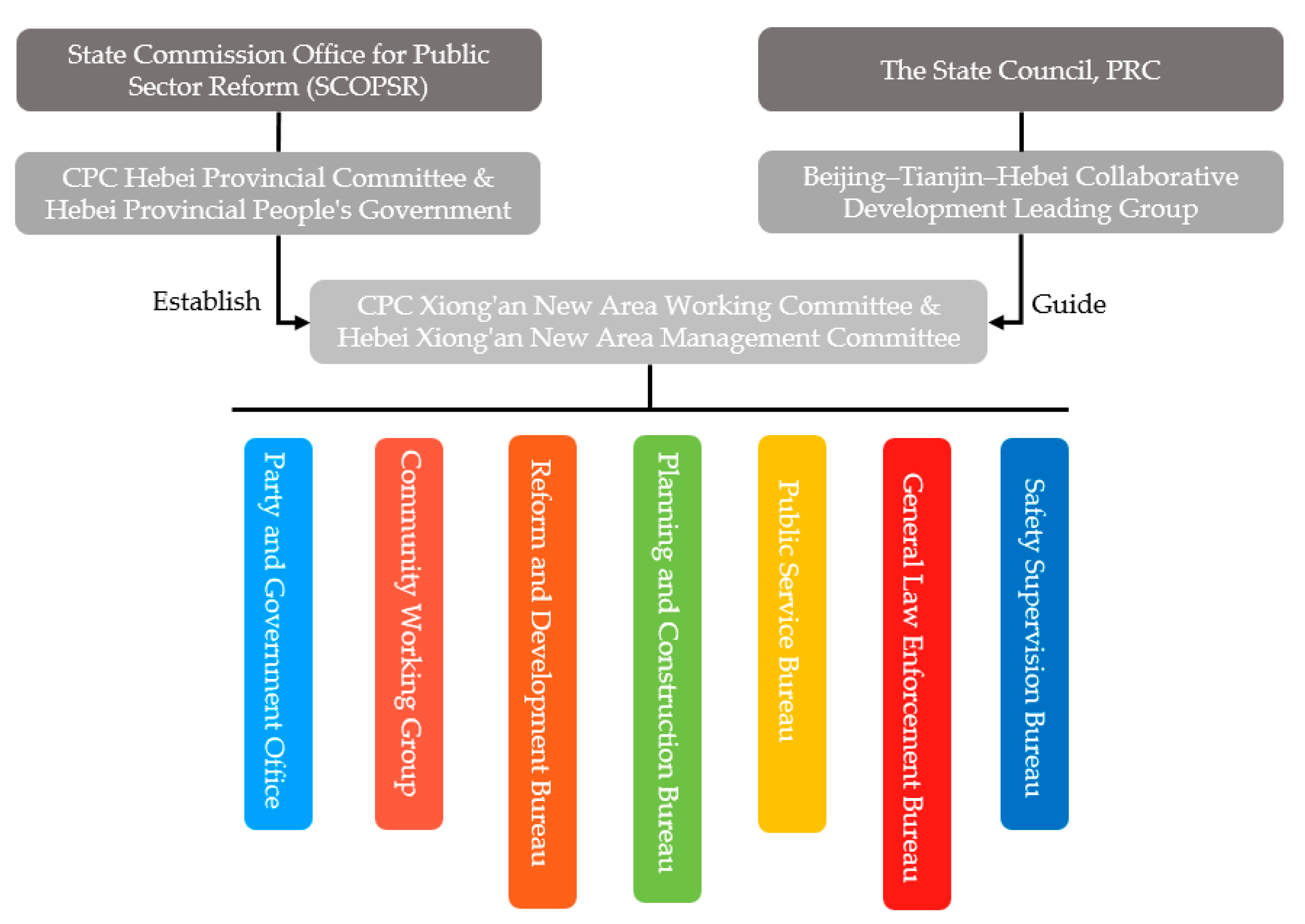
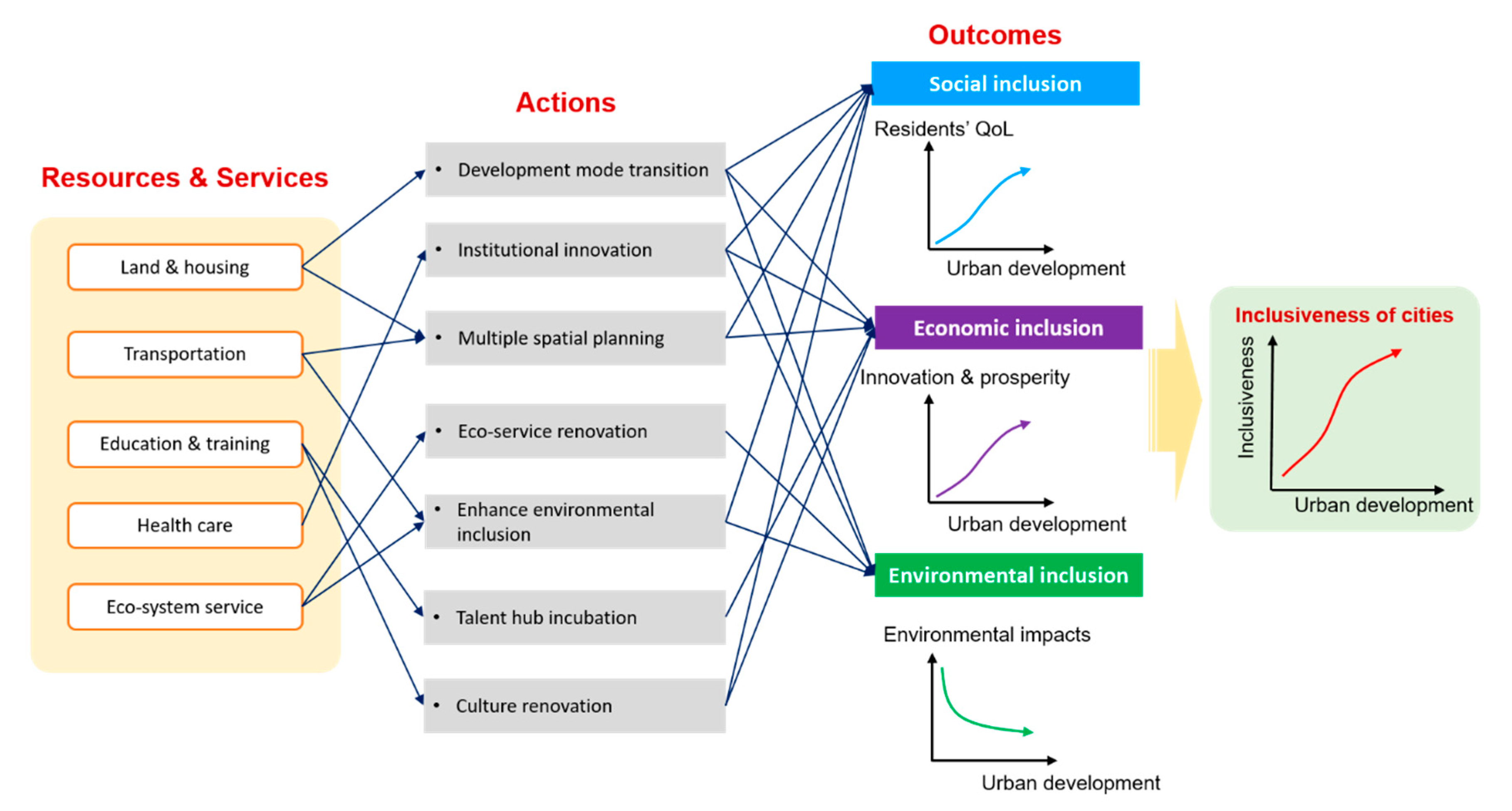
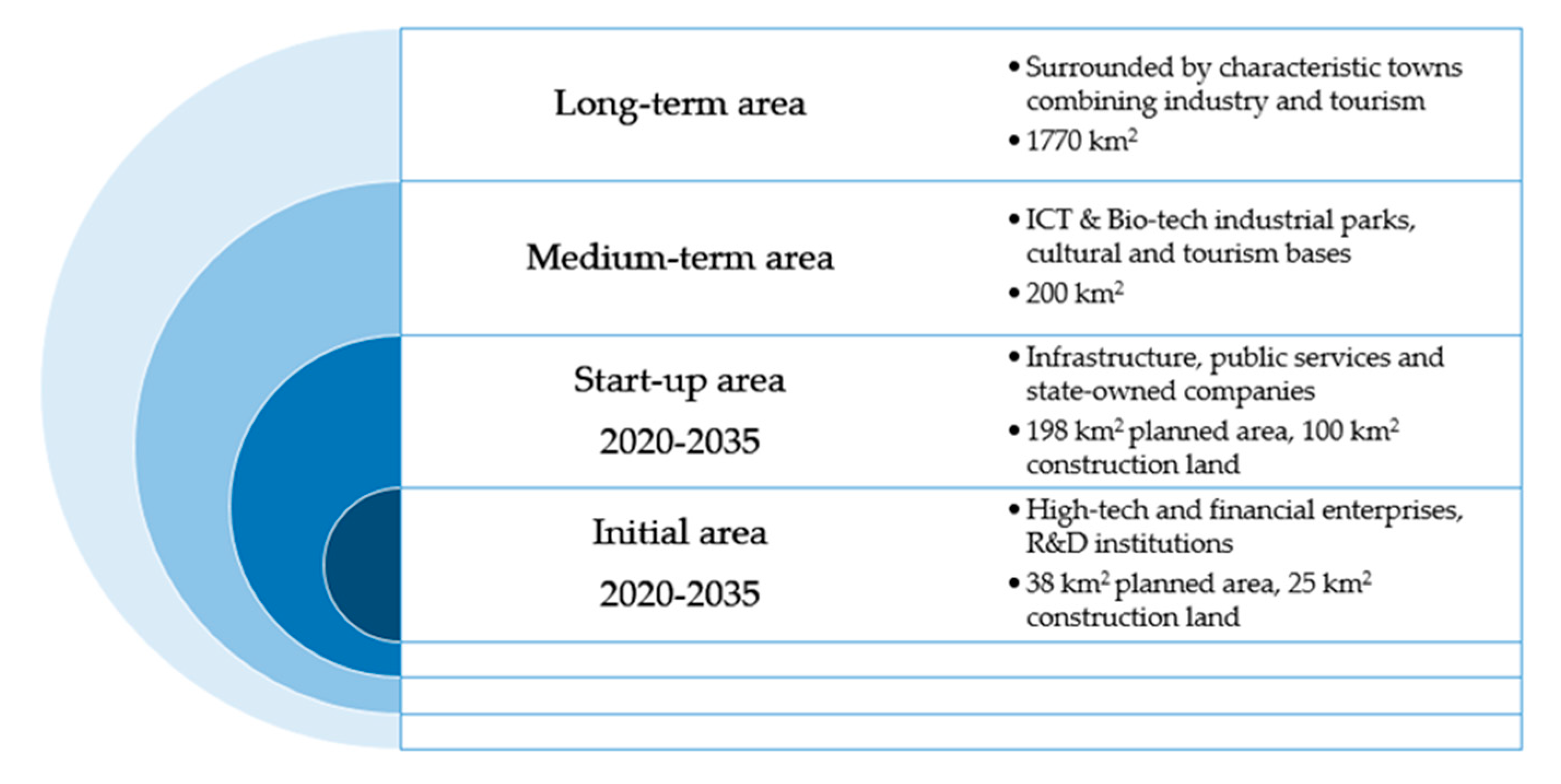
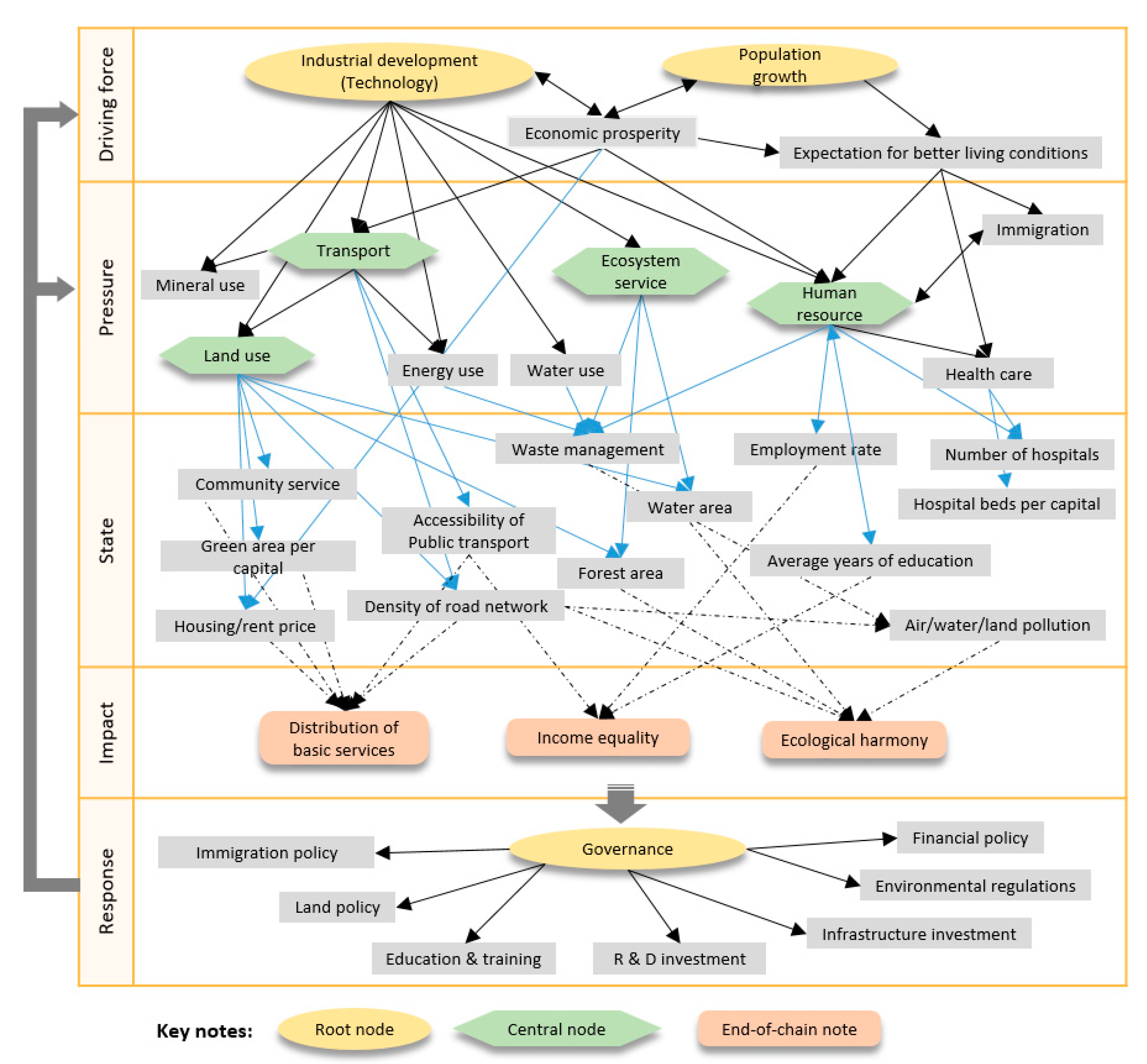
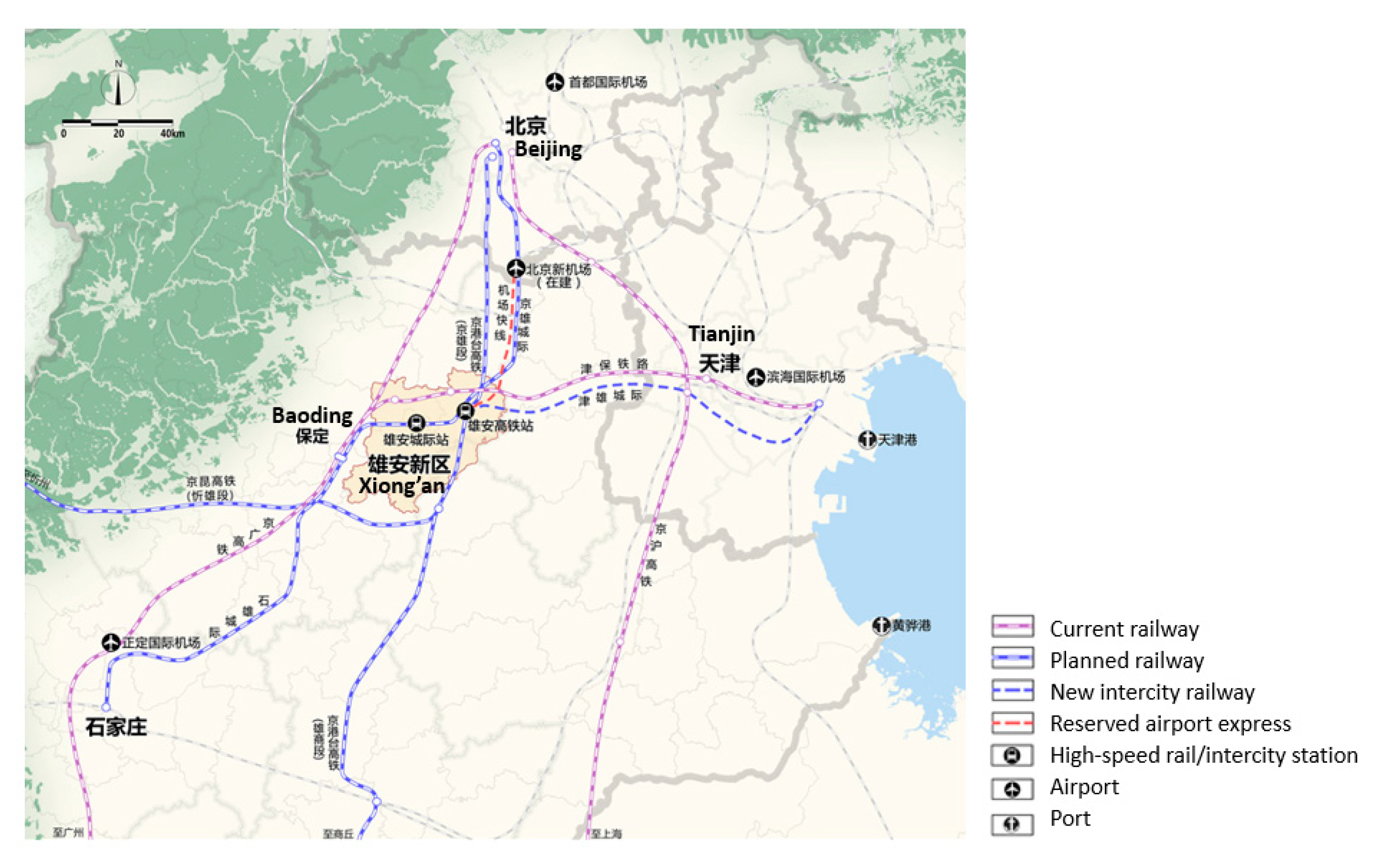
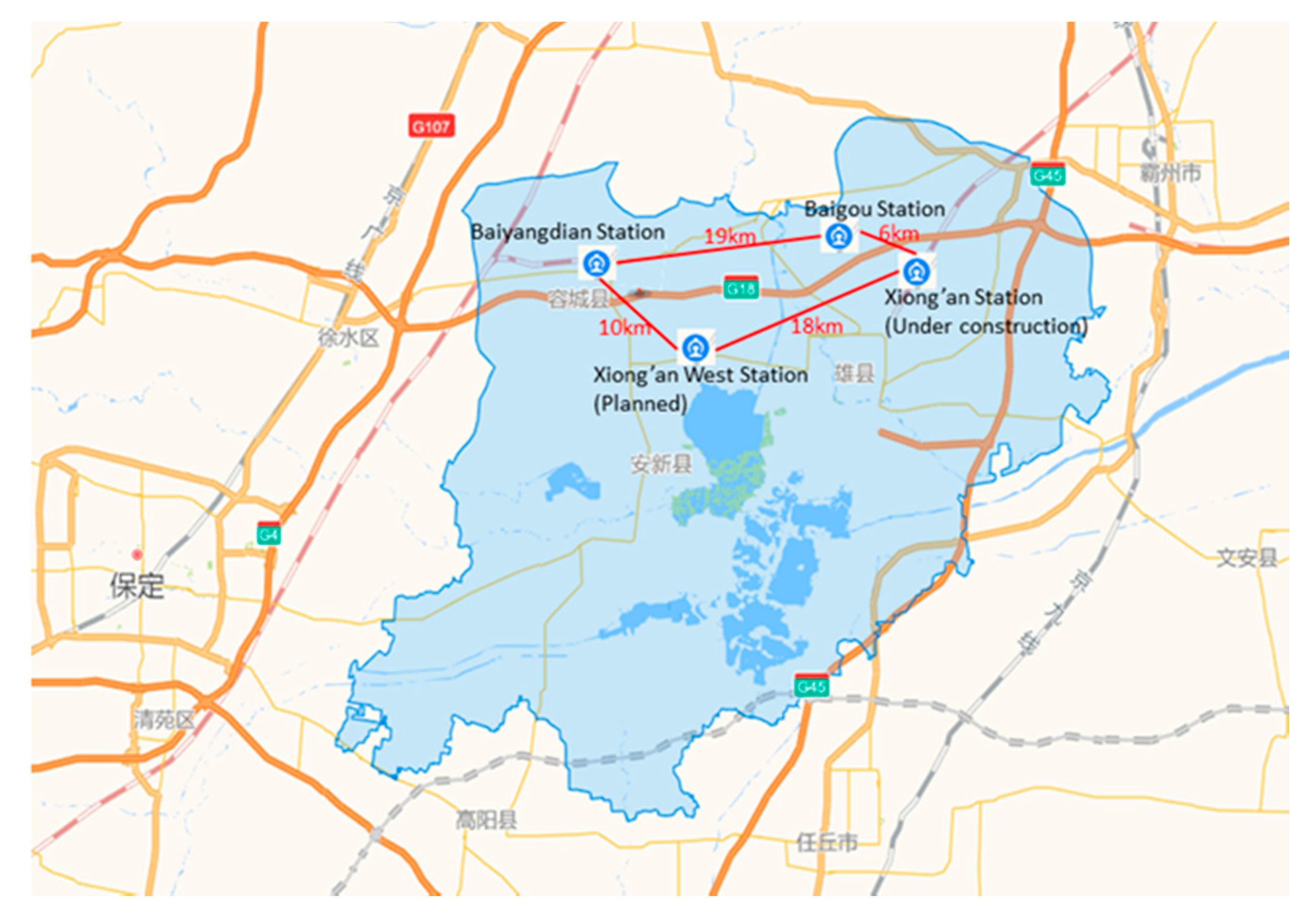
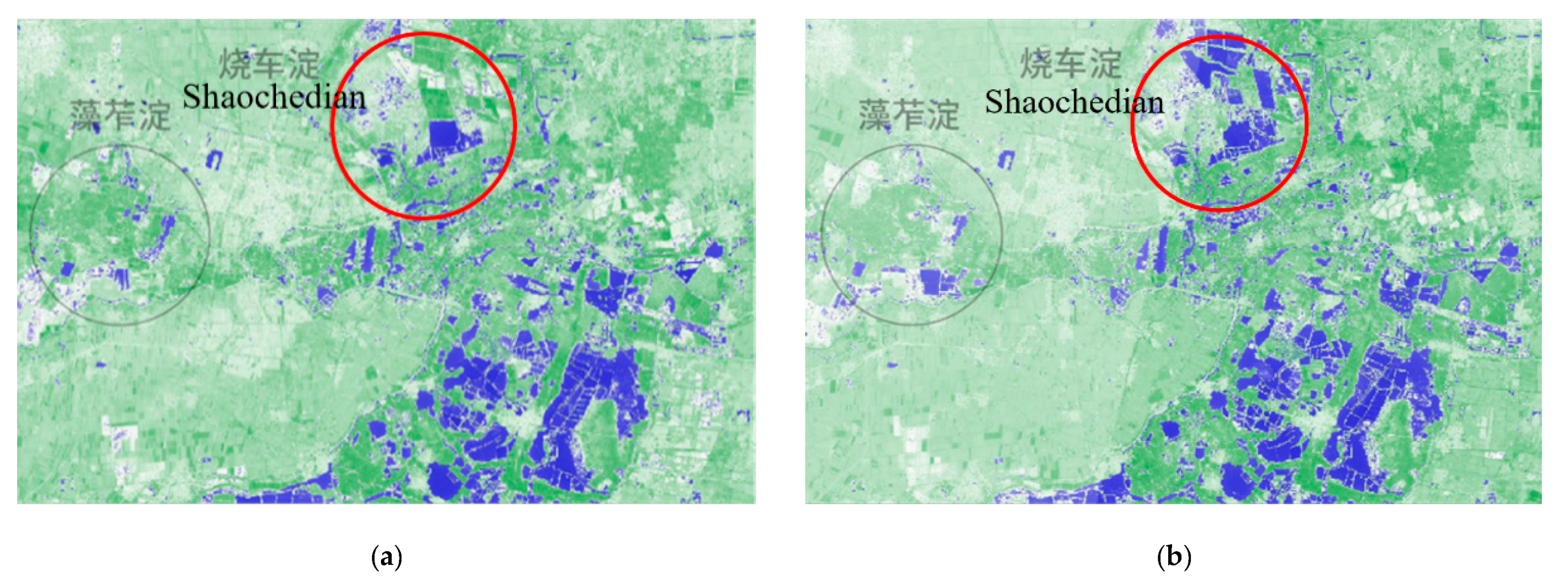
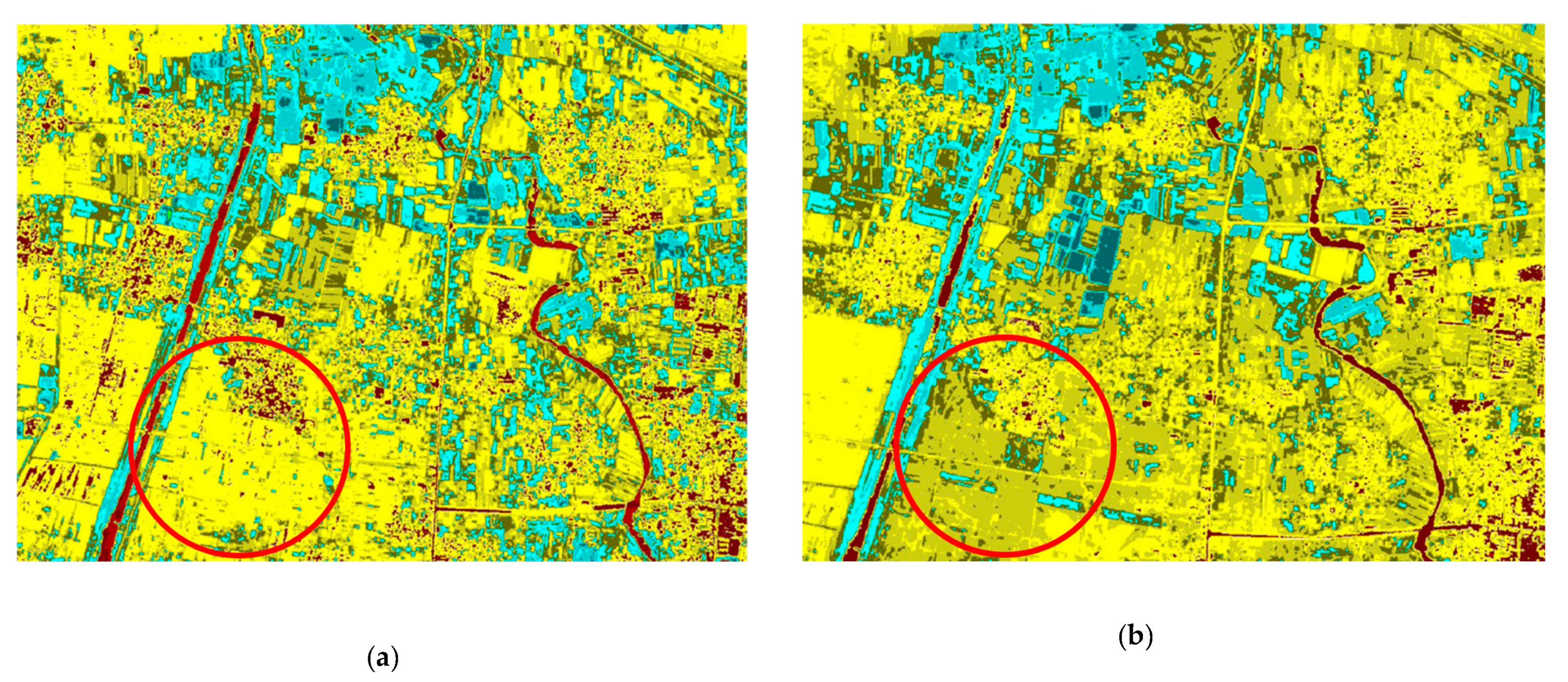
| Type of Data | Initial State before the Establishment of Xiong’an | Policies, Measures and Projects Implemented during the Past Three Years | Up-to-Date Progress |
|---|---|---|---|
| Land and housing | Literature review [56] | Hebei Xiong’an New Area Plan Outline [55] | Interviews with government officials conducted by mainstream Chinese media, including Xinhuanet and Chinanews |
| Transportation infrastructure | Xiong’an’s official website | Hebei Xiong’an New Area Plan Outline [55] | Xiong’an’s official website |
| Demographic and education | Blue Book of Population in Beijing (2018) [58] | Ten Plans to Enhance Employment and Entrepreneurship in Xiong’an New Area [59] | Big Data Report of Xiong’an New Area [60] |
| Ecological services | Literature review [61] | 2018–2035 Master Plan for Xiong’an New Area [57] | Big Data Report of Xiong’an New Area [60] |
© 2020 by the authors. Licensee MDPI, Basel, Switzerland. This article is an open access article distributed under the terms and conditions of the Creative Commons Attribution (CC BY) license (http://creativecommons.org/licenses/by/4.0/).
Share and Cite
Liu, Z.; de Jong, M.; Li, F.; Brand, N.; Hertogh, M.; Dong, L. Towards Developing a New Model for Inclusive Cities in China—The Case of Xiong’an New Area. Sustainability 2020, 12, 6195. https://doi.org/10.3390/su12156195
Liu Z, de Jong M, Li F, Brand N, Hertogh M, Dong L. Towards Developing a New Model for Inclusive Cities in China—The Case of Xiong’an New Area. Sustainability. 2020; 12(15):6195. https://doi.org/10.3390/su12156195
Chicago/Turabian StyleLiu, Zhaowen, Martin de Jong, Fen Li, Nikki Brand, Marcel Hertogh, and Liang Dong. 2020. "Towards Developing a New Model for Inclusive Cities in China—The Case of Xiong’an New Area" Sustainability 12, no. 15: 6195. https://doi.org/10.3390/su12156195
APA StyleLiu, Z., de Jong, M., Li, F., Brand, N., Hertogh, M., & Dong, L. (2020). Towards Developing a New Model for Inclusive Cities in China—The Case of Xiong’an New Area. Sustainability, 12(15), 6195. https://doi.org/10.3390/su12156195








